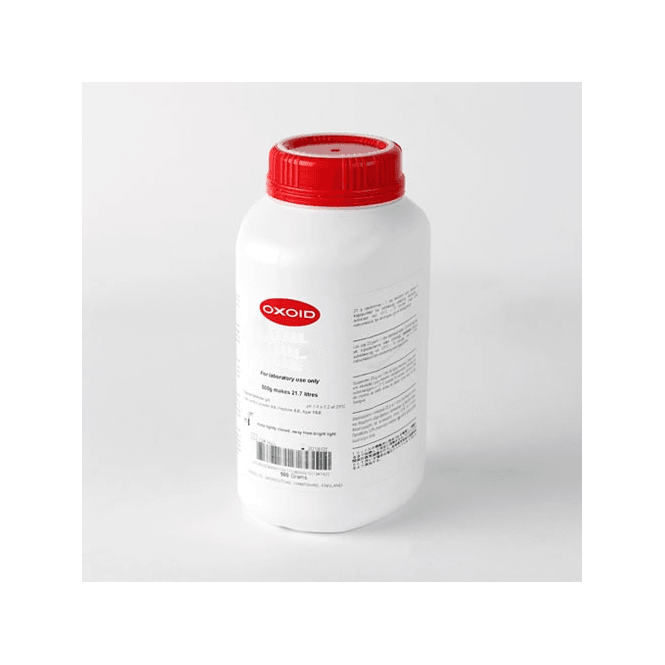Thermo Scientific™ Oxoid™ Mueller Hinton Broth (Dehydrated), 500G
Catalog No :
CAS Number :
Brand :
In Stock
Specifications:
| Application | Microbiology | ||
| Storage Temperature | Room Temperature | ||
| Product Type | Culture Medium | Forms | Powder |
| Product Brand | Thermo Fisher Scientific™ | ||
| Product Grade | Microbiology grade | Formula | For 23.8L medium |
Mueller Hinton Broth is a widely recognized medium used in antimicrobial susceptibility testing, specifically for broth dilution Minimum Inhibitory Concentration (MIC) studies. It shares the same nutrient formulation as Mueller-Hinton Agar (CM0337), ensuring consistency in testing.
Key Features:
- Nutrient Composition:
- Beef infusion (300.0 g/L), casein hydrolysate (17.5 g/L), and starch (1.5 g/L).
- pH: 7.3 ± 0.1 @ 25°C.
- Cation Adjustment: Requires supplementation with Mg²⁺ (10–12.5 mg/L) and Ca²⁺ (20–25 mg/L) after sterilization for accurate MIC determination.
- Applications:
- Antimicrobial susceptibility testing.
- MIC studies for sulfonamides and trimethoprim (with lysed horse blood or thymidine phosphorylase).
- MIC determination for Helicobacter pylori in semi-solid agar format.
Preparation Instructions:
- Weigh: Dissolve 21.0 g of dehydrated medium in 1 L of distilled water.
- Sterilize: Autoclave at 121°C for 15 minutes.
- Adjust Cation Levels: Supplement with Mg²⁺ and Ca²⁺ as per CLSI guidelines.
- Store Prepared Medium: At 2–8°C.
Storage and Shelf Life:
- Dehydrated Medium: Store at 10–30°C, protected from moisture.
- Prepared Medium: Store at 2–8°C. Use before the expiry date.
Appearance:
- Dehydrated Medium: Straw-colored, free-flowing powder.
- Prepared Medium: Light straw to straw-colored solution.
Quality Control:
| Control | Organism | Expected Results |
|---|---|---|
| Positive | Escherichia coli ATCC® 25922 | Turbid growth |
| Pseudomonas aeruginosa ATCC® 27853 | Turbid growth | |
| Enterococcus faecalis ATCC® 29212 | Turbid growth | |
| Negative | Uninoculated medium | No change |
Special Considerations:
- Performance Monitoring: Regularly verify performance using standard quality control organisms. Adjust Mg²⁺ and Ca²⁺ volumes if expected MIC values deviate.
- Thymidine Content: Lower thymidine levels after adding lysed horse blood or thymidine phosphorylase for better MIC results.
- Compatibility: Suitable for aerobic bacteria.
Applications:
- Used in standardized antimicrobial susceptibility testing.
- MIC determination in clinical, food, and pharmaceutical microbiology.
- Evaluation of fastidious organisms like Helicobacter pylori in semi-solid agar formats.
References:
- NCCLS (2000) Methods for Dilution Antimicrobial Susceptibility Tests for Bacteria That Grow Aerobically.
- Thornsberry et al. (1977) Cumitech 6, American Society for Microbiology.
- Swenson & Thornsberry (1978) Curr. Microbiol.
- Kobayashi et al. (1997) J. Antimicrob. Chemother.
This broth is an essential tool for laboratories conducting reliable and consistent antimicrobial susceptibility testing.




 0
0
